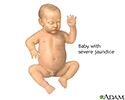Newborn jaundice - what to ask your doctor
Jaundice - what to ask your doctor; What to ask your doctor about newborn jaundice
Newborn jaundice is a common condition. It is caused by high levels of bilirubin (a yellow coloring) in your child's blood. This can make your child's skin and sclera (the whites of their eyes) look yellow. Your child may go home with some jaundice or may develop jaundice after going home.
Below are some questions you may want to ask your health care provider about your child's jaundice.
Questions
- What causes jaundice in a newborn child?
- How common is newborn jaundice?
- Will the jaundice harm my child?
- What are the treatments for jaundice?
- How long does it take for the jaundice to go away?
- How can I tell if the jaundice is getting worse?
- How often should I feed my child?
- What should I do if I am having trouble breastfeeding?
- Does my child need blood transfusions for the jaundice?
- Does my child need light therapy for the jaundice? Can this be done at home?
- How do I arrange to have light therapy at home? Who do I call if I am having problems with the light therapy?
- Do I need to use light therapy all day and night? How about when I am holding or feeding my child?
- Can the light therapy harm my child?
- When do we need to have a follow-up visit with my child's provider?
References
Kaplan M, Wong RJ, Sibley E, Stevenson DK. Neonatal jaundice and liver diseases. In: Martin RJ, Fanaroff AA, Walsh MC, eds. Fanaroff and Martin's Neonatal-Perinatal Medicine . 10th ed. Philadelphia, PA: Elsevier Saunders; 2015:chap 100.
Maheshwari A, Carlo WA. Digestive system disorders. In: Kliegman RM, Stanton BF, St. Geme JW, Schor NF, eds. Nelson Textbook of Pediatrics . 20th ed. Philadelphia, PA: Elsevier; 2016:chap 102.
-
Infant jaundice - illustration
Jaundice is a yellow discoloring of the skin, mucous membranes, and eyes, caused by too much bilirubin (a breakdown product of hemoglobin made by the liver) in the blood. Jaundice is a condition produced when excess amounts of bilirubin circulating in the blood stream dissolve in the subcutaneous fat (the layer of fat just beneath the skin), causing a yellowish appearance of the skin and the whites of the eyes.
Infant jaundice
illustration
-
Infant jaundice - illustration
Jaundice is a yellow discoloring of the skin, mucous membranes, and eyes, caused by too much bilirubin (a breakdown product of hemoglobin made by the liver) in the blood. Jaundice is a condition produced when excess amounts of bilirubin circulating in the blood stream dissolve in the subcutaneous fat (the layer of fat just beneath the skin), causing a yellowish appearance of the skin and the whites of the eyes.
Infant jaundice
illustration
Review Date: 2/16/2017
Reviewed By: Neil K. Kaneshiro, MD, MHA, Clinical Assistant Professor of Pediatrics, University of Washington School of Medicine, Seattle, WA. Also reviewed by David Zieve, MD, MHA, Medical Director, Brenda Conaway, Editorial Director, and the A.D.A.M. Editorial team.

